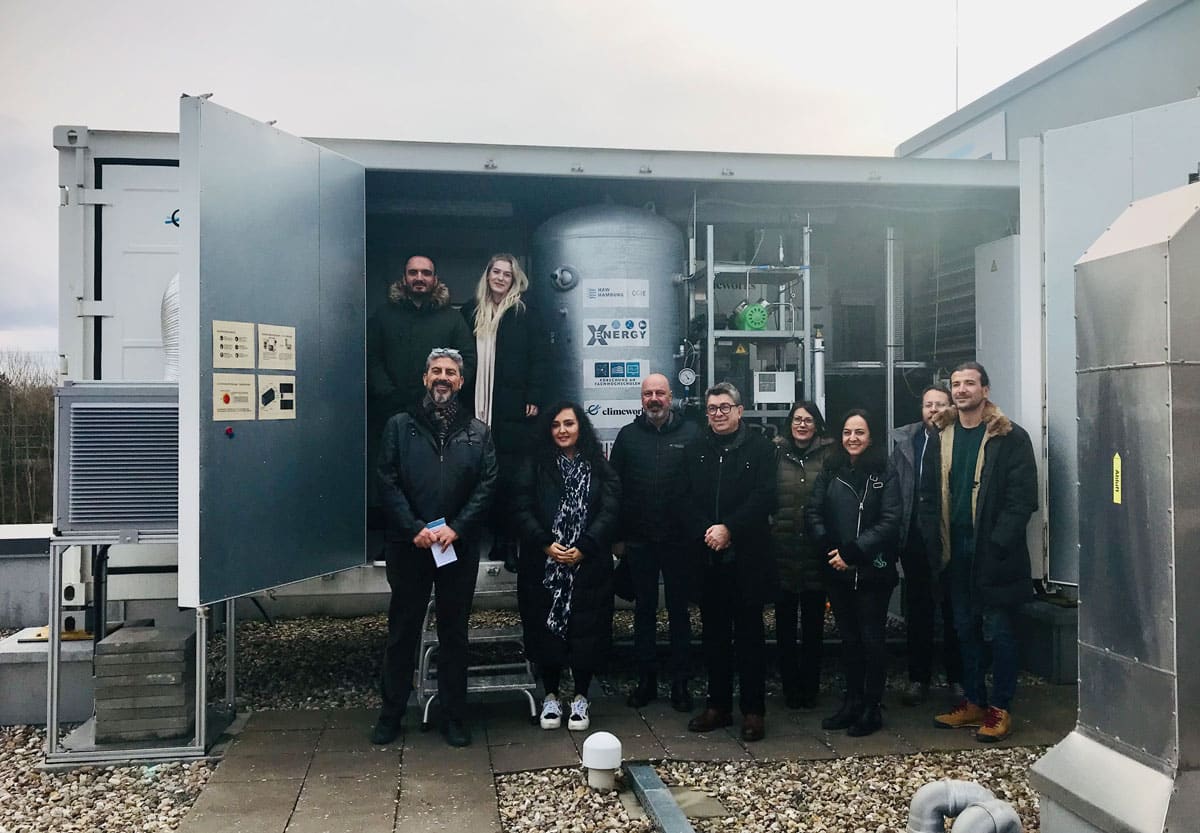
How is Turkey’s energy industry developing?
Sometimes a rooftop walk is all it takes to get an overview of the essential systems for the energy transition and climate protection: On the technology center of the Hamburg University of Applied Sciences, 26 men and women, mostly renewables professionals from the Turkish city of Izmir, stand between solar modules, red steel hydrogen bottles and a pilot plant for capturing carbon dioxide from the air. Everything they see provokes lively interest and copious photos, including the view across to the nearby research wind farm. Here, in the Bergedorf area of Hamburg, the delegation from the German-Turkish chamber of industry and commerce AHK Türkei is able to observe firsthand how the outdoor components work together with the equipment within the building – such as the electrolyzer and the methanation plant. In a way, it’s like the energy transition in miniature.
Not that there won’t be such plants in Turkey, especially since the country published its own hydrogen strategy at the start of this year. Like Germany, Turkey intends to use hydrogen to defossilize its domestic industry. Yet the Izmir engineers are visibly impressed by the system integration and process optimization in Hamburg, resulting in detailed questioning of the scientists from the Hamburg University of Applied Sciences or HAW.
While, on the one hand, the trip is a technical information-gathering exercise, the visit by delegates from Turkey’s third largest city to key renewables projects and organizations in the Hamburg metropolitan region also acts a way to initiate joint energy transition projects. The area around Izmir has ambitions to become a center point for renewable energy and green hydrogen. Similar to Hamburg, the city on the Aegean Sea and its surrounding region is characterized by its port as well as its industrial and commercial activities. Other cities and regions in Turkey which want to position themselves for hydrogen include Istanbul, Antalya and the southern Marmara area.
Fig. 2: Energiecampus Hamburg: Hydrogen. Photovoltaic system. Wind turbines (Curslack research wind farm)
In January 2023, Turkey’s ministry for energy and natural resources presented strategies for expanding hydrogen technologies – with a focus on green hydrogen. The intention is to reach a capacity of 2 gigawatts by the year 2030; this will then rise to 5 gigawatts by 2035 and 70 gigawatts by 2053. As a starting point, those targets seem rather low. It is likely, however, that these will be further increased. After all, Turkey does not only want to produce hydrogen locally to decarbonize its own industry but, as the AHK Türkei explained when asked: “Excess green hydrogen is to be exported.”
German-Turkish collaboration
In keeping with this aim, German economy minister Robert Habeck and Turkish energy minister Fatih Dönmez signed a letter of intent in October 2022 in Berlin “relating to closer collaboration on green hydrogen matters,” as a spokesman for the German economy ministry explained. “The conclusion of the agreement coincided with the fourth German-Turkish energy forum, an important platform for dialog between representatives from politics, business and civil society of both countries within the climate and energy field.”
To support Turkey in climate change mitigation, Germany is making EUR 200 million available through loans from the German state-owned investment and development bank KfW. According to the German economy ministry, the loans “are to be made available to the market via Turkish partner banks and are to be used in particular for funding renewable energy and energy efficiency in Turkey. The International Climate Initiative will make a further EUR 20 million available for improved financing terms, particularly for innovative climate protection measures.”

Fig. 3: View of the electrolyzer in the CC4E
Largest solar plant in Europe
And because renewable electricity is needed for the production of green hydrogen, Turkey is planning to expand its wind power capacity to almost 30 gigawatts by 2035. An even sharper increase is proposed for solar energy, which is envisaged to grow from the 9.4 gigawatts calculated in 2022 to around 53 gigawatts in 2035. In early May, operation began at the biggest solar power plant in Europe, including Asia Minor, an event that went mostly undetected by the German public. The plant, located in the Konya province of central Turkey, has a capacity of 1.35 gigawatts and is also one of the largest facilities of its kind in the world. About 3 billion kilowatt-hours of electricity is expected to be generated every year at the photovoltaic plant in Karap?nar. That’s enough to meet the needs of 2 million people in Turkey, the company Kalyon PV has reported.
With the help of sun, wind, hydropower, geothermal and biomass, the country could completely cover its own electricity demand in the future, according to an analysis by the Turkish hydrogen society NHA. Furthermore, it states that green hydrogen will first help decarbonize domestic industry, especially steel, cement and fertilizer production, so that the country is then ultimately in a position to export hydrogen, which is globally sought after as a base material and an energy storage medium.
German cooperation partners needed
“For Germany companies, there is potential in terms of know-how, project development and technological solutions,” explained the AHK Türkei. The actual size of the potential in the southeastern European nation, which, in any case, is more than twice the landmass of Germany, can already be seen in the current state of play for renewables: Despite its size and favorable wind conditions, the installed capacity of its wind plants, totaling 11.4 gigawatts in 2022, is still relatively modest. A chance, then, for the German wind industry to form business partnerships with Turkish companies? Yes, was the answer from the delegation in Hamburg, and by that the participants do not mean just large system manufacturers, but also small- and medium-size enterprises, suppliers and service providers.
“Following the announcement of expansion targets for offshore wind, the Turkish wind market is gaining new momentum and significance for the export of German technology and know-how,” confirms Jan Rispens, CEO of industry network Renewable Energy Hamburg, whose membership runs to around 240 organizations from the northern part of Germany. “For many years, Turkey has been a major wind market for German- and Hamburg-based companies.” For instance, Nordex, TÜV Nord and EnBW have operations in the country, be it through their own subsidiaries or by engaging in joint ventures with Turkish business partners.
But the changeover from traditional energy sources to renewable forms will take time. In the past, the country has spent vast sums of money on importing fossil fuels, primarily natural gas and oil. “Importing energy cost around USD 97 billion last year alone,” says Y?ld?z Onur, commercial attaché in the Turkish consulate general in Hamburg and who accompanied the Izmir delegation. As a result, costs compared with the previous year have risen by nearly 90 percent, she states, adding that it therefore makes financial sense to concentrate more on domestic energy production in order to lessen dependence on imports.

Fig. 4: Methanation plant in the CC4E
Closeness to Russia
Famously, one of the ways President Erdo?an’s government is seeking to produce more of its own energy is through the use of nuclear power. At the end of April, he inaugurated his country’s first atomic power plant, built by the Russian state enterprise Rosatom, which explains why Russia’s leader Vladimir Putin took part in the ceremony via video. As it happened, the event took place on the same day that polling stations opened in Germany as well as in other countries for Turkish expatriates to cast their vote in Turkey’s election. Erdo?an also took the opportunity of the nuclear power plant’s inauguration to announce the expansion of atomic power and the exploitation of new gas reserves.
Turkish opposition alliance CHP was, however, not opposed in principle to nuclear energy, and is also not against the exploration of new gas fields in the Black Sea. Nevertheless, the opposition did criticize the dependence on Russia and instead wanted to focus on “Turkish technology.” New coal-fired power plants, though, should not be built. According to its policy, the CHP is concentrating on pursuing a green energy transition in all sectors, including agriculture.
Although the May 2023 election mandated the old Turkish government – there is indeed no way of avoiding green hydrogen. At least that is the firm opinion of entrepreneur Ali Köse, not least because of the European Union’s Green Deal and the Carbon Border Adjustment Mechanism, a measure that would require companies in future to make equalization payments for carbon dioxide emissions. Köse is a founder and board member of the Turkish hydrogen association H2DER and CEO of the company H2Energy Solutions. His company’s goal is to make Turkey “fit” for green hydrogen and to export it to Germany. The company, for instance, is currently working on a hydrogen mobility project in Istanbul.
Köse has observed that other companies in this field are likewise sounding out the Turkish market. They are linking up and building partnerships. What is missing, however, is the framework that will provide planning certainty for investors. And, in his view, even the expansion of rooftop solar energy systems is still hampered by bureaucracy. “In Turkey, fewer roofs are fitted with PV than in Germany,” says Köse, who regularly travels between the two countries. “Due to the solar radiation level here, every megawatt of installed PV capacity generates roughly double the amount of electricity as in Germany.”
Author: Monika Rößiger








